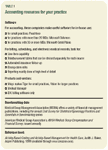PRACTICE MANAGEMENT "IN THE TRENCHES": PART 1 - Fundamentals of practice finance
You may not have been trained as a CEO, but unless you sharpen your business skills, your clinical skills may be all for naught. In the first of our 3-part series, a seasoned physician executive outlines the tools needed to manage people, profits, and policies.
Throughout medical school and training, we focus virtually all our attention on learning how to deal with the medical needs of our patients. Because of this emphasis, most of us enter practice with relatively little idea of how to deal with the dollars-and-cents essentials that will determine whether we can keep our doors open and actually offer the clinical care we've been trained to provide.
But common sense dictates that each physician think of his or her practice as a small growing business. That means being aware of all your sources of cash inflow and outflow and taking positive steps to maximize the former and minimize the latter.
For most of the past 10 years, I have served as the President and Chief Executive Officer of the Mount Kisco Medical Group, a multispecialty group located about 40 miles north of New York City. During that decade, the group has nearly tripled in size, going from about 35 physicians to more than 100, and from approximately 200 staff members to more than 600. I've learned a lot of lessons presiding over this growth process and weathering a decade of managing a busy and demanding multispecialty group. Many of these lessons are applicable to single-specialty ob/gyn practices as well.
Create a financial backbone with auditing, benchmarking, and budgeting


